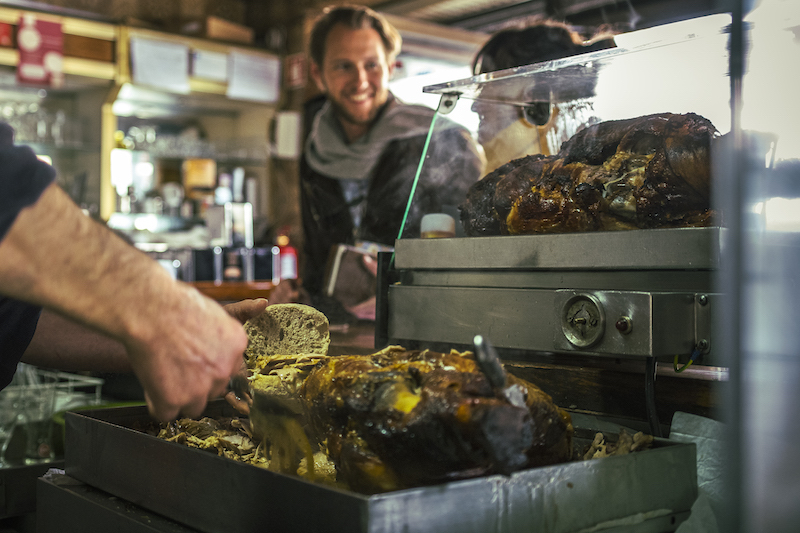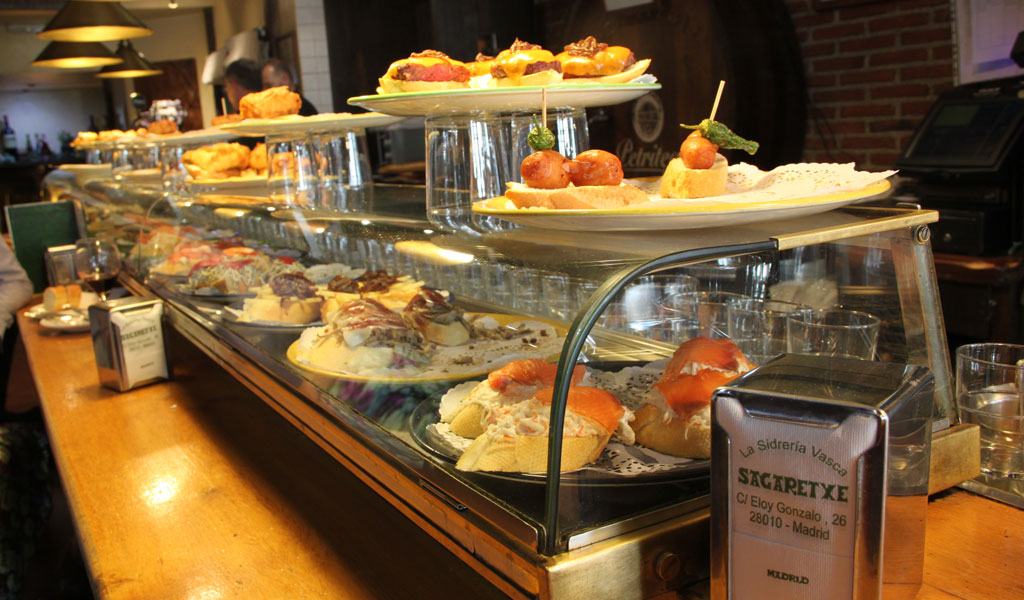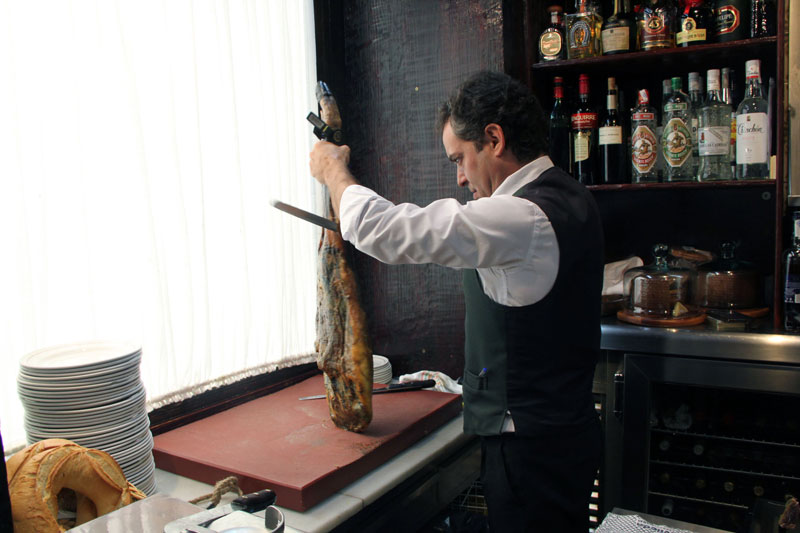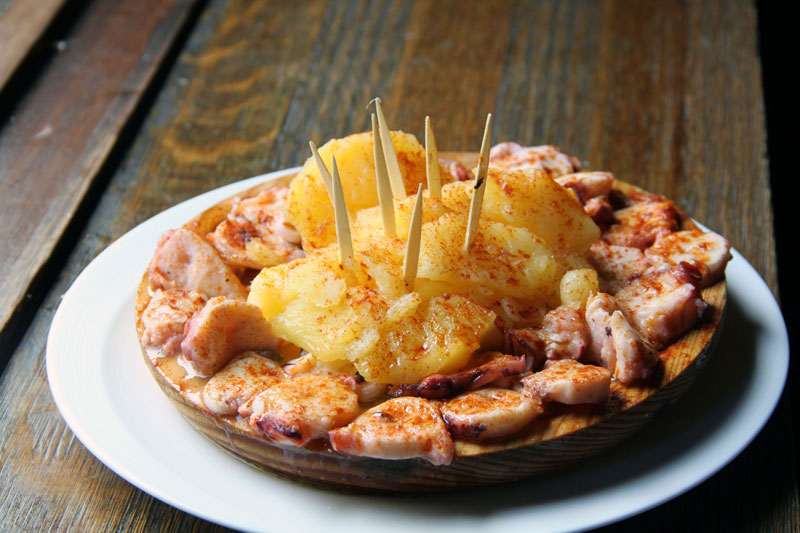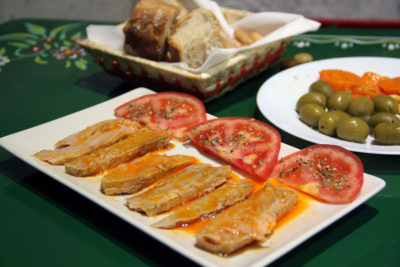We can't find the internet
Attempting to reconnect
Something went wrong!
Hang in there while we get back on track
Search results for "Francesca Savoldi"
Lisbon
Post-Colonial Lisbon: Mozambique
Lisbon’s communities from Portugal’s former colonies provide the strongest link to the country’s past, when it was the hub of a trading empire that connected Macau in the east to Rio de Janeiro in the west. Though integral elements of Lisbon life, these communities can sometimes be an invisible presence in their adopted land, pushed out to the periphery of the city. With our “Postcolonial Lisbon” series, CB hopes to bring these communities back into the center, looking at their cuisine, history and cultural life. In this third installment of the series, we dive into Lisbon’s Mozambican community.
Read moreLisbon
Post-Colonial Lisbon: Cape Verde
On a narrow and, until recently, slightly forgotten street in Lisbon’s city center, a simple Cape Verdean eatery is holding its own. As one of the few tascas serving up African dishes in this part of town, Tambarina, with its dozen tables and keyboard and mics set up in the corner, bears testimony to this urban quarter’s historical connections to the people of Africa’s northwestern archipelago. Rua Poço dos Negros – a street whose name (poço means “pit” in Portuguese) reveals a disturbing history as a mass grave site for the bodies of enslaved people – is on the border of what until two decades ago was known as “the triangle.” This is an area extending to São Bento and which in the 1970s became home to a new group of migrant Cape Verdeans.
Read moreLisbon
Post-Colonial Lisbon: Angola
Those normally finding themselves craving Angolan flavors in central Lisbon head straight to Mouraria, the medieval downtown neighborhood that has experienced a conceptual conversion of its peripheral status into a landmark of cultural and culinary diversity. Despite it being the area with the highest density of Angolans in Lisbon’s city center, Angolan restaurants open and close at a rapid rate, with now-shuttered CB favorites Palanca Gigante and Shilabo’s falling prey to this trend. In the beginning, these restaurants were only popular among the Angolan community, but nowadays, due to the rehabilitation of the neighborhood, a new clientele is discovering them. Now that we can’t get the country’s iconic national dish, muamba, at Shilabo’s or Palanca Gigante, we head to Rato instead for a taste of Angola.
Read moreLisbon
Post-Colonial Lisbon: Brazil
Despite Brazil being the largest of Portugal’s former colonies, the presence of its people in Lisbon has only been felt recently. During the 1950s and 60s, Brazilians in Portugal were limited to small groups of students, a few migrant adventurers and those Portuguese descendants born in Brazil who decided to return to the motherland. However, since the 90s, a more regular coming-and-going has been taking place between Brazil and Portugal. This pendulum-like swing of migration is a consequence of their respective political and economic crises and moments of growth. At the beginning of that decade, many Brazilians moved to Lisbon in the wake of the difficult inflationary crisis that was affecting South America’s biggest nation. By 2005, they formed the largest foreign community settled in the Portuguese capital, with more than 30,000 residents.
Read morePorto
Casa Guedes: Roasted to Porkfection
Forget the famous francesinha. The best sandwich in Porto – arguably in the country – can be found in a little 1970s tile-lined eatery; the unremarkable interior belies the iconic status of its most celebrated dish. Served up on the corner of Praça Poveiros, a square named after the fishermen from the storied maritime city Póvoa de Varzim, located just north of Porto, the sandes de pernil (roast pork sandwiches) are a curious joy to watch being assembled as well as, of course, to eat. One by one, roast pork legs are slowly cooked in the huge oven in the kitchen behind the bar of Casa Guedes. They are then served directly from the roasting tray by the owner himself, Mr. Cesar.
Read moreLisbon
O Trevo: Chicken Soup for the Portuguese Soul
A legendary snack bar sits on a corner of Praça Luís de Camões, a busy square dedicated to one of Portugal’s most celebrated poets (his most famous work is the epic Os Lusíadas, a fantastical interpretation of the Portuguese voyages of discovery, narrated in Homeric style). The square is a major thoroughfare in Chiado and witnesses thousands of journeys daily. Many passing through make a pit stop at O Trevo. This tiny and perpetually packed eatery has historical roots in the area; traces of the old sign, “Leitaria Trevo,” over the marble entrance reveal its beginnings as a dairy some 80 years ago.
Read moreLisbon
Taberna Sal Grosso: The Revivalists
On a steep, narrow curve that winds up from Santa Apolonia station, a growing group of people waits. Whatever the weather, a small crowd will always be there, ready for the low doors to open at 8 p.m. Taberna Sal Grosso, which seats around 25 people, has been holding its own, quietly, for five years. Now, a seat at this small spot is one of the most coveted in town. Sal Grosso’s modern takes on classic dishes are fun and inexpensive, particularly if you are not on a Portuguese salary. This tightly packed cubby was located in the right spot when the turistificação of the historic center hit and the intense surge in foodie footfall took over neighborhoods like Alfama.
Read moreLisbon
O Churrasco: Diamond in the Touristy Rough
Rua das Portas de Santo Antão is probably the most touristy food street in Lisbon. This pedestrian road is full of restaurants with guys outside hawking their specials and menus offering out-of-season sardines and frozen pizzas. But there’s more to this downtown thoroughfare than just luring American vacationers to overpriced mediocrity. Located on this road, buzzing even before the tourist boom thanks to its central location, musical theaters and local commerce, is one of the city’s timeless classics, O Churrasco. This restaurant looks different from the usual chicken restaurant, with impressionistic paintings hanging from its wooden walls and waiters in bow ties, and has been a camouflaged gem for many years, a particular favorite of middle-class families and theater lovers.
Read moreLisbon
Cervejaria Ramiro: Crustacean Station
Cervejaria Ramiro is the undisputed temple of seafood in central Lisbon. The 50-year-old business represents an old-school type of eatery: a beer hall where the seafood is fresh and cheap, with a choice from the daily menu or directly from the large aquariums that look out to the street. Taking up two floors of a late-Art Nouveau building on Avenida Almirante Reis, Cervejaria Ramiro is perpetually crowded. The clientele has not been affected by the recent urban regeneration of the area, which is turning the degraded Intendente neighbourhood, long affected by social exclusion, into a fashionable district. In fact, the restaurant was already popular in the 1970s, when eating seafood was new to the capital.
Read moreLisbon
Casa do Alentejo: Grand Setting, Humble Food
Walk in through an anonymous iron gate, halfway down a road you would assume to be completely spoiled by mass tourism, and a surprise awaits. Casa do Alentejo in downtown Lisbon is one of the many old-school regional associations in the city – but none of the others look quite like this. Many who come across this 17th-century building think they are visiting a Moorish palace, perhaps a remainder of the time Muslims ruled over Al-Ishbuna. It’s a misleading impression. In fact, this was a generic building that served different uses over its long history, including as a residence and as a school.
Read moreElsewhere
Sagaretxe: Madrid's Pintxos Pioneer
The ascendance of Spanish gastronomy has largely had a Basque signature, which, together with the Catalan scene, is seen as the vanguard in Spanish haute cuisine. But while Nouvelle Basque has gotten all the spotlight lately, the food culture of this northern region has always been outstanding, thanks to its abundant rains and a territory that encompasses the Cantabrian Sea and Ebro River. Basque taverns are largely known for their pintxos, a kind of tapas that are more sophisticated in taste as well as in design. At certain times of day these small plates fly nonstop out of the kitchen, usually chosen at the chef’s discretion.
Read moreLisbon
Gleba Moagem & Padaria: Friends in Knead
Bread may be fundamental to Portugal’s food culture, but over the last few years the baked goods landscape in the country has begun looking increasingly uniform, with fake neo-classic franchising playing no small part in its decline. Although many old and family-run bakeries can’t keep up with the competition – especially in the cities – there are a few initiatives kneading a small revolution. Courses, workshops and experimental research are creating a new class of future bakers who often rework old techniques. Among them is 21-year-old Diogo Amorim. Gleba, his bakery, with its contemporary look and historic techniques, attracts customers from all over Lisbon. It opened six months ago in Alcantara, a neighborhood that shows traces of many past lives, from industrial working-class to the aristocratic.
Read moreLisbon
Fumeiro de Santa Catarina: Up In Smoke
Though it’s an age-old method for preservation and flavor enhancement all over the world, the smoking of meat, fish, and cheese is not a notable tradition in southern Europe. In Portugal, in the old days, salt curing was more common – particularly for the national staple, cod. However, the presence of smoking traditions in the north, particularly around the Minho river, indicates the possibility that the Vikings’ favorite method for cooking fish may have reached all the way to the northeastern Iberian peninsula.
Read moreElsewhere
Lucio: Urban Treasure
Sitting at a table in Lucio, a long-established tavern in the heart of Madrid’s most famous tapas street, is a singular experience that has a slightly surreal, Buñuel-esque touch. Queues formed of Madrid’s born-and-bred elite snake past the elegant wooden bar, the coiffed connoisseurs greeted with affection by the landlord himself as they wait to eat his restaurant’s specialty dish. Lucio’s signature white suit and the hushed, apparent dignity of the place are quite a contrast to the actual holy grail itself: a plate of fried eggs and fries. The eponymous owner keeps repeating in a whisper that this is the most famous restaurant in all of Spain; perhaps it truly is.
Read moreLisbon
Bagos: All the Rice Moves
In downtown’s Chiado, a slightly bougie-looking restaurant profits from the crowds leaving weekend performances at the São Luiz theatre, a former 19th-century cinema. This place also takes advantage of a common and ubiquitous Portuguese ingredient – rice. Bagos (“grains of rice”) has just a few tables over two floors; the upstairs level is the more suitable for a business lunch partaken while tram 28 trundles by. The vibe is refined but simple, and that is reflected in how the humble staple on its menu is reworked in the kitchen. Chef Henrique Mouro explores the many ways in which different varieties of rice are prepared across the country, revealing a very typical component as the basis for all sorts of invention.
Read moreLisbon
Espaço Açores: Off the Island
Inside the humble municipal market building of an elderly neighborhood between Belém’s touristic spectacles and the sprawling Monsanto park is the oldest Azorean restaurant in the Portuguese capital. In non-descript Ajuda, with a view over Ponte Abril 25, this place transports Lisboetas with tastes of the remote and alluring Atlantic archipelago. When Espaço Açores opened 10 years ago it was one of four restaurants in Lisbon serving the food of the Azores. The others have since closed, a fact that at first seems difficult to understand: food from these islands is incredibly good and more often than not reproduces traditional dishes from the mainland, albeit with considerably better ingredients.
Read morePorto
Francesinha: Porto's Heart-Stopping Sandwich
A gloppy, meaty, cheesy brick served in a pool of sauce and with a mountain of fries: please meet the francesinha, the culinary pride and joy of the city of Porto. Today, restaurant billboards proclaim in many languages that they serve the best version in the world, revealing the genuine power of this artery-clogging combination that, incredibly, was originally conceived as a snack. We have to say it though: eating a francesinha is worth every last calorie. This dense sandwich, which is impossible to eat just with your hands, is often considered the lusophone version of the croque monsieur.
Read moreLisbon
Drink Local: Lisbon's Craft Beer Revival
Portugal may be known for its abundance of wines, but beer also has a centuries-old history here, with production rooted in local traditions. It’s a story that has quietly been forgotten, but it seems like now is the right moment for a revival. Portugal’s beer landscape has since the 1940s been dominated by the Sagres-Super Bock duopoly, whose common lagers are nothing to write home about. Created out of a merger between previously competing associations, these two new brands (grouped under Central de Cervejas e Unicer) had a huge impact on Portuguese beer habits. The new industrial focus on a simple and standard product effectively wiped out hyper-local hops culture.
Read moreLisbon
Santa Apolónia: Station to Station
Cities experiencing rapid urban transformation often find themselves suspended between past and future, with those respective cultures in close juxtaposition. The Santa Apolonia train station, a simple neoclassical building from the 19th century that once served as Lisbon’s central rail hub, is a good example of this; a visit to its north and south sides reveal different routines, atmospheres and of course, flavors. On the waterfront, a few former dock warehouses are the home of gourmet palates. Cais da Pedra, the project of the famous chef Henrique Sá Pessoa, is a modern restaurant decorated in stone, iron and mirrors.
Read moreElsewhere
O Pazo de Lugo: Galician Formula
Galician restaurants have had a strong presence in Madrid since the 1950s, when the northwestern region’s economic crisis triggered a solid exodus of people towards industrial Spanish cities. This migratory wave, alongside the fact that Galician gastronomy was (and still is) considered one of the best in the country, meant a boom of new restaurants in the capital. It was in the 1970s when brothers Francisco and Marcial Javier moved to Madrid from Lugo, an interior city of Galicia known for its Roman walls, rainy weather and rich food.
Read morePorto
Matosinhos: Song of the Sea
Matosinhos, a small city just north of Porto, is used to change. It has an industrial air to it, due to its 19th-century harbor, and its past prosperity was connected to the fish-canning sector, which peaked during World War II and declined from the beginning of the 70s. The numerous abandoned warehouses attracted nightlife during the 1990s, with clubs finding a fertile zone for noise. The completion of the long-delayed tidal pool, built by Portugal's starchitect, Alvaro Siza (who was born in the city), put it firmly on the map again after the project was delayed for decades. In January, the launch of the new, spiralling cruise ship terminal added to the contemporary design-y feel that has been developing on its otherwise rugged coastline.
Read moreLisbon
Holiday Gifts in Lisbon: A Carioca's Coffee
Though ceramic dishes or tinned sardines are the standard take-home souvenirs for visitors to Lisbon, a less traditional – but still unique – gift from the city is the source of the warming aroma that permeates its cafés morning, noon and night. A strong bica (espresso) is an integral part of Lisbon’s smellscape, and the few chimneystacks in sight over peripheral skylines reveal that there are still local businesses providing beans to restaurants and traditional stores here. Consuming this product, which has a long history, is deeply embedded in the city’s day-to-day, but cultural shifts (today it is quaffed more at the bar rather than at home), means many of the old coffee shops are now obsolete.
Read moreLisbon
Best Bites 2016: Lisbon
Lisbon is still one of the best cities in Europe for fresh, unpretentious seafood dining, despite the onslaught of fads and newfound taste for speculative real estate. Eating mollusks here – as at a cervejaria-marisqueira, a sort of old-school beer and seafood house – is not at all associated with the luxury it symbolizes elsewhere. Here, it is normal to dig out the insides of unique, claw-like barnacles or suck the heads of the freshest prawns for a decent price in a genuine atmosphere. And in such restaurants, forget the lime tart or crème brûlée afterwards: the purist’s dessert after a shell-laden chowdown is a prego – a garlic-laced beef sandwich that couldn’t be fancy even if it tried.
Read moreLisbon
Estrela da Bica: Local Star
Despite being home to Lisbon’s most photographed street, Bica has maintained its close-knit-community feel, with encroaching internationalization still held at arm’s length from these bumpy cobbled lanes and steep stairways. The small residences here have generally been passed down through generations, meaning a steadfast family vibe where everyone’s laundry is, literally, there for all to see. Estrela da Bica is a cozy, rustic restaurant at the bottom of this tiny hill district that perhaps marked the first sign of middle-class interest here. Historically inhabited by fishing families, Bica is becoming increasingly touristy by day and, thanks to the several bars around, more of a hangout at night.
Read moreLisbon
Damas: Funky Kitchen
At the end of Rua da Voz do Operário, the main road that leads up to the hilltop of the previously sleepy Graça neighborhood, is a new, hip Lisbon kitchen that is reflecting the city’s growing hunger for great food and a good time. Damas, as the name indicates, is run by two women who have both previously worked in some of the city’s well-known food institutions, including Chapito. The restaurant, bar and club has been popular pretty much since it launched in 2015, thanks to its combination of knowledgeable chefs, classic and not-so-classic dishes done well, and a regular music program that ranges from punk to afro-beats.
Read moreElsewhere
La Caleta: Cádiz in Madrid
Though it has always taken a backseat to Barcelona in foodie terms, Madrid, the sprawling Spanish capital, has upped the ante with its increasingly varied gastronomy and adaptation of new food concepts. As a centralized city, the cultures of separate Spanish regions – still a political talking point – is reflected here in a gastronomical microcosm: Galician eateries, Basque pintxos, Asturian snacks, etc. This, together with the ir de tapas in different neighborhoods, new avant-garde chefs, traditional taverns and a few imported hipster inventions, creates an interesting mosaic among the city’s already high density of restaurants and bars. Lavapiés is Madrid’s best-known neighborhood for cultural plurality, and that includes its food offerings.
Read moreLisbon
Tascardoso: Trend Buster
Close to Jardim do Príncipe Real, the singular, beautiful park built in the 18th century above one of many underground cisterns of Lisbon’s public water system, is a cozy, rustic Portuguese eatery defying – while also benefiting from – the trends of its surroundings. Tascardoso is a typical tasca often frequented by tourists in the increasingly chic Principe Real neighbourhood, which tops one of the city’s seven hills and commands that soft Lisbon light until the last moment of the day. While fad food and French-owned business ventures abound, the restaurant’s popularity has risen with the booming interest in the area: it is especially difficult to get a table at Tascadorso for dinner.
Read moreLisbon
Poema do Semba: The Musical Kitchen
Behind a discreet entrance on one of Lisbon’s principal avenues, a sophisticated environment with a minimal interior houses a loyal Luanda-Lisboa jetset crowd who is here for the great food – and great music. Poemas do Semba, its walls decorated with black-and-white photographs, is an unlikely find in this neighborhood. Santos is the former stomping ground of the Portuguese nobility; today some of their former palaces have been turned into embassies or luxury hotels. Students and a design-y crowd have taken over as well, thanks to the nearby college. This exclusive African restaurant was opened in 2014 by the famous Angolan singer Paulo Flores, a semba exemplar who has numerous albums to his name.
Read moreLisbon
Capital Grapes: Lisbon's Home-Grown Wine Scene
September heralds the start of Portugal’s wine season, and while harvests from Alentejo and the north usually get all the attention, many forget that Lisbon itself also offers much to try from its own soil. This old wine-producing area was previously known as Estremadura, which extends from the capital to about 100 km to the north. In 2010, the rebranded Lisbon wine region (Região dos Vinhos de Lisboa) was born. Production has since expanded on average around 25 percent annually, with 70 percent of sales now allocated for export.
Read moreLisbon
Tasca Kome: Osaka on the Tagus
After almost a century of desertification, it’s sometimes hard to believe the state of downtown Lisbon – Baixa – today. Hotels, startups, boutiques and restaurants are exploding up and down these long, narrow avenues, originally modelled on 18th-century Parisian thoroughfares, and all but abandoned by the 1990s. As the few remaining owners of the old light fittings shops and cheap canteens pray to the gods of damage limitation, a few of the new businesses do fit well into the surroundings. Japanese canteen Tasca Kome is one of them. Like all typical Portuguese tascas – traditional taverns and bars that serve food – the atmosphere at Tasca Kome is cozy and friendly.
Read moreLisbon
On the Waterfront: Cacilhas, the Other Side of Lisbon
Cacilhas is the waterfront area of Almada, a small city reachable via a €1.20 ferry ride from Lisbon’s Cais do Sodré terminus. The district is heavily marked by its shipbuilding past and has an industrious character that, for now, is still preserved in its food culture. Right in front of its boat station is a concentration of traditional marisqueiras, typical seafood houses from where you can glimpse a sweeping view of almost the whole of Lisbon across the other side. The seafood platter is a must in any of these traditional spots. It is usually composed of stuffed crab, spiny lobster and giant prawns, accompanied by the classic amêijoas à bulhão pato – clams cooked in garlic, coriander, pepper and olive oil.
Read moreLisbon
Tentações de Goa: (Tri)continental Cuisine
Hidden within Mouraria’s maze of narrow streets is a tiny eatery offering usually hard-to-find fare in Lisbon: Goan cuisine. Situated a couple of minutes away from Martim Moniz – a revamped square that some years ago was named the multicultural core of the capital – this haven of flavors is a veteran of food diversity in the neighborhood. Tentações de Goa (“Temptations of Goa”) opened 20 years ago, when the multi-ethnic character of the area was more marginalized and not considered cosmopolitan, and when international restaurants were not as numerous and crowded as they are today. In the 1990s Maria, the now-busy owner of the small restaurant, was just a regular customer here, an avid fan of the elderly Goan woman who originally ran the place.
Read moreLisbon
O Satelite da Graça: Down to Earth
Perched on Lisbon’s highest hilltop, Graça has a villagey feel and is probably the best district to absorb stunning views over the Portuguese capital. Home to plenty of bakeries, cafes and two of the city’s most beautiful viewpoints, it does, however, risk irreversible damage because of the real estate boom affecting much of the city center. It is, for now, still a charming area, with an elderly population and remnants of working-class neighborhood life. To get to the panoramic views during summer, there are two options that don’t involve being stuck in a taxi: climbing steeply up through the irregular lanes of Alfama or Mouraria, or following the route of the iconic and crowded tram 28.
Read moreLisbon
Summer Picnics: Lisbon's Ribeira das Naus
Summertime in Lisbon can mean some very hot days, making locations that get a cool Atlantic breeze at the end of the afternoon ideal for throwing down a blanket. One such perfect spot for a picnic in Lisbon is the new promenade along the Tagus River, located between Praça do Comercio and Cais do Sodré. Ribeira das Naus, formerly part of the docklands where ships were built, was renewed in 2014 as part of the redevelopment plan for the central waterfront, transforming the historic quay into a large public space with a pedestrian walkway and aligning park. On the large steps that hug the water, you can also watch the sunset over the April 25 Bridge.
Read moreLisbon
Marisqueira O Palácio: Other Fish in the Sea
June is probably Lisbon’s most euphoric month, due to the city’s biggest street party that celebrates the patron Saint Anthony. Though the festival officially takes place on June 12-13, the party runs all month long, especially in Alfama, Mouraria and Graça. The smoke of sardines grilling, colorful decorations, makeshift neon fairgrounds and pimba music blaring from outdoor speakers enliven the narrow roads of these traditional neighborhoods. The bedlam isn’t for everyone, however, and for those who want to find a quieter spot that still celebrates fresh, seasonal fish, Largo de Alcântara is a good alternative. Located in the western part of the city, between Santos and Belém, this zone is a concentration of cervejarias and marisqueiras.
Read moreLisbon
Taberna da Rua das Flores: Lost & Found
Lisbon’s tiny Taberna da Rua das Flores is almost always crowded, with barely enough room for staff to explain (and often translate) to hungry clients the dishes chalked up on its only blackboard menu. With around 10 marble-topped tables in a narrow, vintage-style eatery that takes no reservations, its small scale and increasing popularity makes for a challenging place to serve food – and yet, the staff are always smiling. The restaurant’s original, contemporary take on the forgotten tavern fare of the city, as well as its patient service and shared love of local ingredients, make it well worth the waiting time.
Read moreLisbon
Casa de Macau: Imperial Dining Room
The era of Portugal’s seafaring might was so long ago, it seems almost like a myth – one still patriotically related by locals today. Gastronomic evidence of the country’s imperial past remains, however, particularly in Lisbon, where Angolan, Brazilian and Goan eateries can be found among the many other restaurants serving non-Portuguese food. Yet, despite Macau being under Portuguese control for around four centuries, passing into Chinese administration only in 1999, Macanese cuisine is still a mystery. Lisbon has yet to see even one Macanese restaurant open. There is a place here, however, to eat food from Macau: a cultural association in between Alvalade and Areeiro on a main road that leads to the airport, far from Lisbon’s center.
Read moreLisbon
Santa Clara dos Cogumelos: Fungus Fanatic
In the heart of Alfama’s historic flea market is a surprise: Lisbon has a small restaurant dedicated entirely to mushrooms. Located inside the charming old market building from where there is an excellent view over the Tagus river, Santa Clara dos Cogumelos (Saint Clara of Mushrooms) is a very peculiar eatery: from starter to finish, including desserts, are unexpected combinations of shiitake, oyster, porcini, black trumpets or truffles, all cooked using a variety of techniques.
Read moreLisbon
Dine Together: Lisbon's Community Kitchens
It’s a buzzing Thursday night at Associação Renovar a Mouraria (ARM), a one-room bar and eatery found in a nook at the top of some ancient stone steps leading up from Rua da Madalena. Dani, a local tattooist born in Java, is cooking for around 35 people as part of the weekly Jantar Cruzado (“dinner crossing”), an initiative aimed to improve social inclusion in this old part of town through the simple act of making food.
Read moreLisbon
Bar Covense: Local Hero
Like many other cities in Europe, Lisbon’s burger trend has been growing strong, with gourmet versions and strange national adaptations overtaking the capital. But the bifana, Portugal’s quintessential hot sandwich, will always trump any trend for locals who want quick nourishment. Composed of a thin pork filet cooked in a sauce made from white wine, garlic, bay leaves, lemon and lard, the bifana is an irreplaceable cultural habit.
Read more



